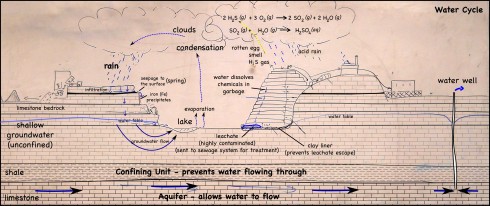
The water cycle is intricately tied to all the other topics that came up on our visit to the quarry/landfill. For some things, the tie to water is direct and inextricable.
- It’s groundwater that dissolves the pyrite in the coal seam and then precipitates an orange iron stain on the quarry cliffs.
- Rainwater seeping into the landfill leaches out chemicals that have to be prevented from getting into the groundwater, rivers or lakes.
- Gases like hydrogen sulfide can react with water (and oxygen) in the air to produce acid rain. Not to mention that water is needed for the decaying processes that produce the hydrogen sulfide, and other landfill gases like methane, to begin with.
For other things the link to water is not necessarily so obvious:
- The sediment that was compressed into the limestone that is being quarried, was formed beneath the shallow seas that once covered this region in the geologic past. Limestone is also dissolved by rainwater to create caverns, underground rivers and spaces for geodes.
- Methane gas not only requires water for it to be released via decomposition of garbage, but also produces carbon dioxide when burned. Carbon dioxide is a greenhouse gas, so it affects the global temperature and contributes to the melting glaciers, rising sea levels and changes in climatic patterns such as the amount of rain we’re going to receive in the midwest.
The water cycle picture starts simply, but gets complicated very quickly.
